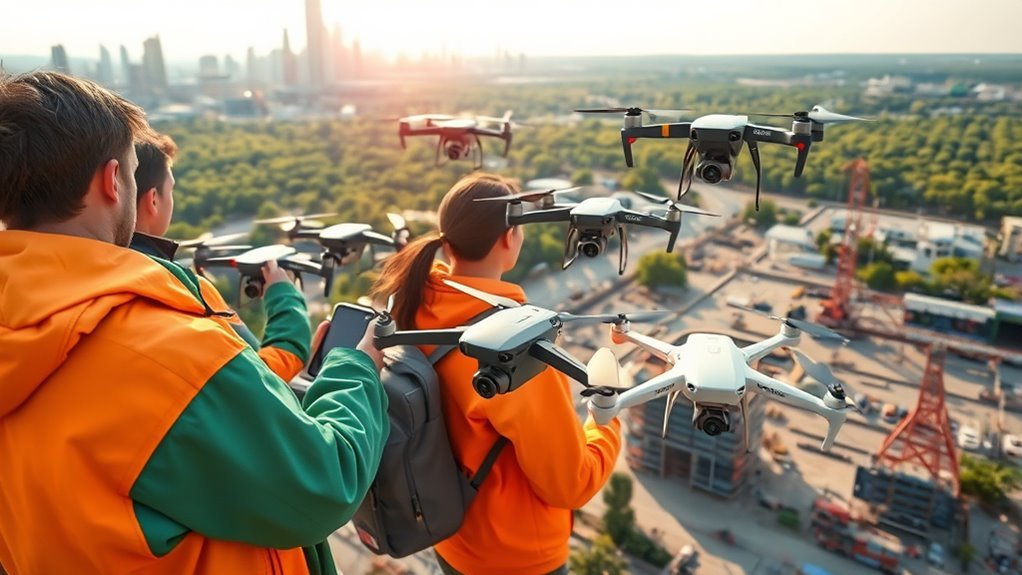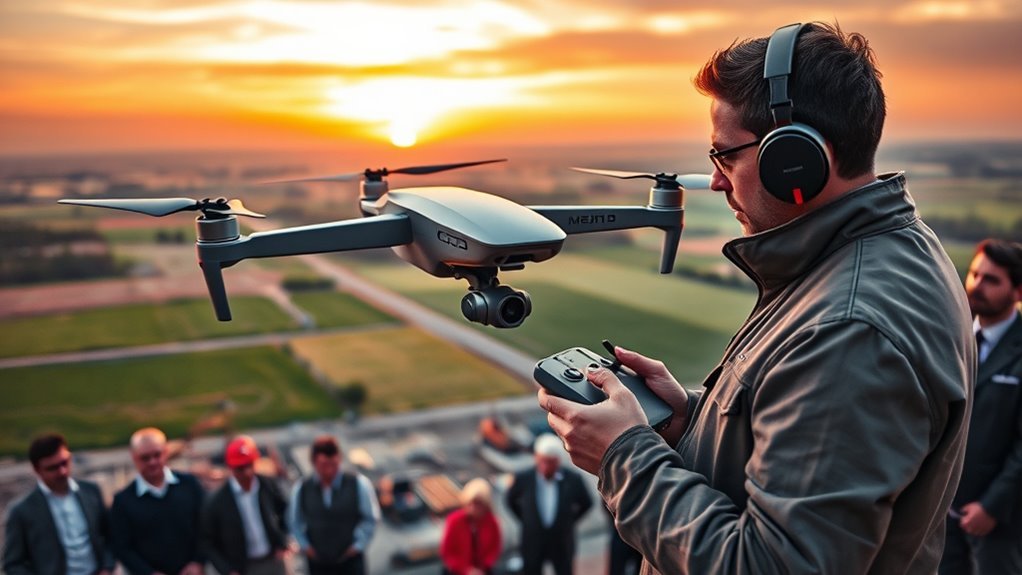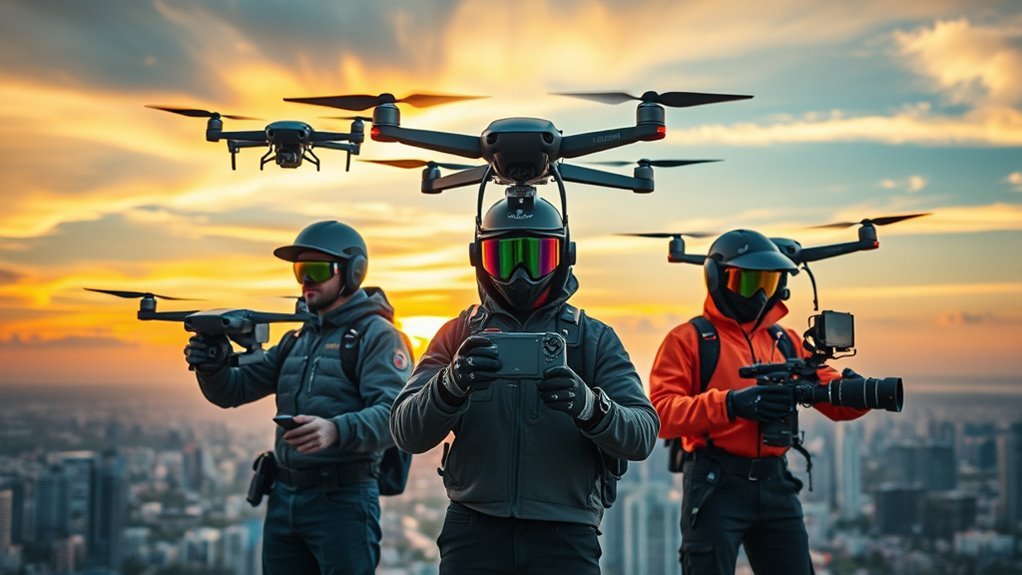Drone pilots are in high demand today for several compelling reasons. Industries are expanding applications, from agriculture to disaster management, leveraging drones for real-time data collection and analysis. The cost-effectiveness and efficiency of drones streamline operations, enhancing productivity. Safety improvements in hazardous environments reduce risks for personnel. Regulatory changes and advancements in technology make drones more accessible, drawing interest from the public. With growing demand for skilled professionals, it’s clear why this field is thriving. Discover more about these trends and their impact.
Expanding Applications Across Industries

As industries evolve, the applications for drone technology are expanding at an unprecedented rate. You’ll find drones revolutionizing agricultural monitoring, providing farmers with real-time data to optimize crop yields. In real estate marketing, aerial photography showcases properties from breathtaking angles, attracting potential buyers. Drones facilitate infrastructure surveying, enabling quicker assessments of roads and bridges. They’re also essential in wildlife conservation, tracking animal populations without disturbing habitats. In disaster management, drones survey areas for damage assessment, while environmental assessments benefit from their ability to capture hard-to-reach locations. Urban planning utilizes drones for mapping and visualization, and entertainment production leverages them for stunning aerial shots. Finally, insurance evaluations have become more efficient, reducing the hassle of on-site inspections. The integration of high-resolution imaging in agricultural drones enhances the accuracy of crop health analysis, leading to more informed decision-making. Additionally, these drones employ AI algorithms to identify crop stress and pest threats, ensuring targeted interventions that bolster overall farm productivity.
Enhanced Data Collection and Analysis

While the rise of drone technology has transformed various industries, one of its most significant impacts lies in enhanced data collection and analysis. Drones provide a unique perspective, allowing you to gather high-resolution data efficiently. This capability leads to powerful insights through data visualization and predictive analytics.
Imagine capturing:
- Detailed agricultural assessments with real-time crop health analysis
- Comprehensive infrastructure inspections that reveal potential issues before they escalate
- Environmental monitoring that tracks changes in ecosystems over time, including advanced crop monitoring solutions that help optimize resource use.
With these tools at your disposal, you can make informed decisions that drive progress. As industries embrace the freedom offered by drone technology, the demand for skilled drone pilots who can navigate this data landscape will only continue to grow. Additionally, the integration of advanced GPS systems enhances the accuracy and efficiency of data collection in agricultural applications.
Cost-Effectiveness and Efficiency

Given the increasing pressures on budgets across various sectors, the cost-effectiveness and efficiency of drone technology have become undeniable. You’ll find that utilizing drones can lead to significant cost savings, as they often replace more expensive methods of data collection and surveillance. By streamlining processes, drones enable operational optimization, allowing tasks to be completed faster and with fewer personnel. This efficiency not only reduces labor costs but also minimizes downtime, making your operations more agile. Whether you’re in agriculture, construction, or logistics, the financial benefits are clear. Embracing drone technology empowers you to allocate resources where they’re most needed, enhancing productivity and ultimately driving your success in a competitive landscape. Moreover, the global expansion of drone applications opens new avenues for diverse market penetration and operational freedom. Drones also offer GPS stabilization that enhances security and ease of use, further contributing to their value in various industries.
Safety Improvements in Hazardous Environments
In hazardous environments, drone technology greatly enhances safety through remote inspection capabilities, allowing you to assess risky areas without putting personnel in danger. By implementing effective risk mitigation strategies, you can minimize potential accidents and streamline operations in challenging conditions. Additionally, drones provide essential support during emergencies, ensuring a quicker response while maintaining safety standards. Furthermore, Brinc’s thermal imaging can be integrated with drone technology to enhance visibility and detection capabilities in low-visibility situations. Drones equipped with superior sensor sensitivity offer greater operational freedom in low-light conditions, further improving safety during critical missions.
Remote Inspection Capabilities
As industries increasingly turn to drone technology for remote inspections, the safety benefits in hazardous environments become glaringly obvious. By utilizing drones, you can harness remote monitoring benefits that not only protect workers but also enhance efficiency. Imagine:
- Inspecting toxic waste sites without human exposure
- Surveying towering wind turbines from a safe distance
- Monitoring structural integrity of bridges in real-time
These aerial survey techniques allow for thorough inspections without the risk inherent in traditional methods. Drones can access hard-to-reach areas, capture high-resolution imagery, and gather data swiftly, ensuring that potential hazards are addressed proactively. Embracing this technology means prioritizing safety while exploring new avenues for operational freedom, ultimately leading to a smarter, safer future in industrial inspections.
Risk Mitigation Strategies
While remote inspections greatly enhance safety in hazardous environments, implementing robust risk mitigation strategies is equally important for protecting personnel and assets. Engaging in thorough risk assessments and hazard identification can drastically reduce risks. Here’s a look at some common strategies:
| Strategy | Description |
|---|---|
| Regular Training | Guarantee pilots are well-trained in safety protocols. |
| Pre-Operational Checks | Conduct equipment checks before each flight. |
| Real-Time Monitoring | Use drones equipped with live feedback systems. |
| Incident Reporting | Establish a clear process for documenting hazards. |
Emergency Response Support
Effective emergency response support can greatly enhance safety in hazardous environments, particularly when drones are integrated into the response strategy. Drones play a crucial role in disaster management, improving search operations by providing real-time data and aerial perspectives. This technology allows responders to act swiftly and effectively.
- Rapid assessment of damage: Drones can quickly survey affected areas, giving you an extensive view of the situation.
- Search and rescue capabilities: Equipped with thermal imaging, drones can locate missing persons in challenging terrain.
- Delivery of supplies: Drones can transport essential medical supplies or food to isolated or dangerous locations.
Regulatory Changes and Increased Accessibility
As drone regulations continue to ease, you’re likely finding more opportunities to enter this rapidly growing field. Coupled with the availability of affordable drone technology, it’s becoming easier than ever for aspiring pilots to get started. Understanding these changes can give you a competitive edge in a market that’s increasingly demanding skilled operators. Furthermore, this shift towards innovation in the drone sector is creating new avenues for skilled pilots to leverage advanced technologies and enhance their operational capabilities. The rise of Chinese drone brands has significantly contributed to the accessibility of cutting-edge tools in the industry.
Easing of Drone Regulations
With the recent easing of drone regulations, the landscape for aspiring drone pilots has transformed considerably, making it easier than ever to enter this burgeoning field. Regulatory clarity in drone policy has opened doors to a wide range of opportunities, allowing you to explore the skies with confidence.
Imagine the possibilities:
- Operating a drone for real estate photography, showcasing stunning properties from above.
- Conducting aerial inspections of infrastructure, ensuring safety and efficiency.
- Capturing breathtaking footage for film and media, telling compelling stories from unique perspectives.
These changes not only enhance accessibility but also empower you to embrace your passion for flight. As regulations continue to evolve, the demand for skilled drone pilots will only grow, paving the way for a future full of potential.
Affordable Drone Technology
Although the demand for skilled drone pilots is rising, the affordability of drone technology has become a significant factor in making this field accessible to a broader audience. With budget-friendly technology emerging, you can now explore opportunities that were once out of reach. Take a look at how affordable drones can empower you:
| Affordable Drones | Benefits |
|---|---|
| Entry-Level Models | Perfect for beginners |
| Enhanced Features | Improved usability |
| Lower Maintenance Costs | Greater longevity |
| Diverse Applications | Creative freedom |
The increased accessibility of drones means you can pursue your passions—be it photography, agriculture, or surveying—without breaking the bank. Embrace this technological evolution and seize the chance to elevate your skills in a growing market.
Advancements in Drone Technology
The rapid evolution of drone technology has transformed industries and created new opportunities for skilled pilots. With advancements in autonomous flight, you can explore the skies like never before. Imagine being part of a future where:
The evolution of drone technology is revolutionizing industries, creating exciting opportunities for skilled pilots in unprecedented ways.
- Drones conduct intricate aerial mapping, delivering precise data for urban planning.
- Advanced sensors enable real-time monitoring of agricultural fields, optimizing yields effortlessly. The integration of obstacle avoidance technology ensures safer navigation in complex environments.
- Innovative designs allow for longer flight times, expanding your operational reach.
As these technologies continue to develop, your expertise in piloting drones becomes increasingly valuable. The demand for pilots who can navigate this landscape will only grow, offering you the freedom to work across diverse sectors, from construction to conservation. Additionally, understanding the importance of safety features in drones will enhance your operational capabilities and ensure safer flights. Embrace the possibilities that come with mastering advanced drone technology.
Growing Public Interest and Engagement
Public interest in drone technology has surged dramatically in recent years, driven by its potential to revolutionize various sectors. This growing public awareness has sparked increased community engagement, as more people recognize drones’ benefits in areas like agriculture, delivery, and disaster response. The incorporation of advanced AI integration in drone technology further enhances their capabilities, making them even more appealing for various applications.
| Sector | Benefits |
|---|---|
| Agriculture | Precision farming |
| Delivery | Faster logistics |
| Disaster Response | Enhanced safety |
As you explore this exciting domain, you’ll find that the demand for skilled drone pilots is tied to this rising enthusiasm. People are keen to learn about drones, participate in workshops, and understand their applications, further fueling the need for trained professionals to guide these innovations into our everyday lives. The emergence of advanced drone models, such as the DJI Air 3S, showcases the evolving capabilities that attract new users to the field.
Frequently Asked Questions
What Qualifications Do I Need to Become a Drone Pilot?
To become a drone pilot, you’ll need to meet regulatory requirements and complete a certification process. Don’t worry; while it might seem complex, mastering these steps opens up a world of aerial opportunities for you.
How Much Can Drone Pilots Earn Annually?
As a drone pilot, salary expectations can range considerably based on industry trends. You might earn between $50,000 to over $100,000 annually, influenced by experience, location, and the specific sector you choose to work in.
What Are the Most Popular Drone Models for Beginners?
When choosing a drone, consider features like camera quality and battery life. For beginners, models like the DJI Mini and Ryze Tello are great. Remember to follow beginner tips for safety and ideal flying experiences.
Are There Age Restrictions for Becoming a Drone Pilot?
You might think age limits are strict, but they’re flexible. Generally, you can start flying drones at 16 with pilot certifications. This opens doors for young adventurers enthusiastic to explore the skies and capture their dreams.
How Can I Find Drone Pilot Job Opportunities?
To find drone pilot job opportunities, explore drone pilot networks and employ effective job search strategies. Networking with industry professionals and utilizing online platforms can greatly enhance your chances of landing fulfilling positions in this growing field.

